Fuchsias are popular summer bloomers. In order to enjoy a blooming fuchsia, you have to know its requirements regarding planting and care.

With its extravagant flowers, the fuchsia (Fuchsia) a welcome change in the garden and gives it an exotic flair. The popular evening primrose plant (Onagraceae) is actually by no means indigenous, but comes from the mountain regions in South and Central America. Brought to Europe in the 19th century. Due to this fact, some pointers are needed when growing the flowering plant. We present everything about the fuchsia - from the most popular species to planting and care.
contents
-
Fuchsias: characteristics and origin
- Fuchsia color: what colors are there?
- Hanging or standing fuchsias?
- Are fuchsias poisonous?
-
Fuchsias: Popular species, cultivars and wild forms
- Popular species of fuchsia
- Standing fuchsia varieties
- Hanging fuchsia varieties
- Fuchsia varieties: Hardy fuchsia varieties
- Wild forms of the fuchsia
-
Planting fuchsias in the garden: location and substrate
- Fuchsias: the right location
- When do fuchsias go outside?
- Fuchsias in pots: which substrate is the right one?
- Propagating fuchsias yourself: how does it work?
-
Maintaining fuchsias: important tips and tricks
- Watering fuchsias properly
- Fertilize fuchsias properly
- Cut fuchsias
- Skillfully hibernate fuchsias
Fuchsias: characteristics and origin
The fuchsia is a genus that encompasses a total of over 100 different species, which are indigenous to large areas of South America and isolated in the Pacific region. The plant was named after the German physician and botanist Leonhart Fuchs, which is how it got its unusual name. The fuchsia has achieved particular popularity due to its striking flowers, which present their flower stalk to all pollinators. An overview of the most beautiful Fuchsia varieties get here.
Fuchsia color: what colors are there?
What makes the fuchsia so popular as an ornamental plant in gardens is the sheer unbelievable diversity of its flowers. The thousands of varieties ensure a diversity that is second to none and literally covers all color combinations. Sepals and petals usually have different colors and range from white, yellow, red, pink, purple to blue - including all the nuances in between.
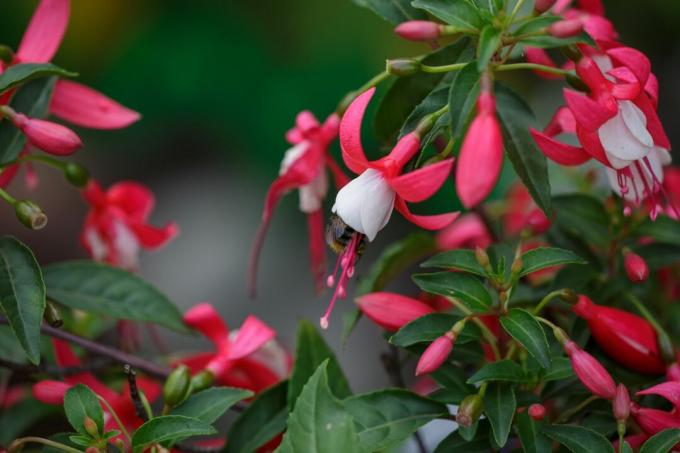
Hanging or standing fuchsias?
When buying a fuchsia, the question inevitably arises: should you choose a hanging variety or a standing one? The answer to this depends on the one hand on personal taste, but also on the destination. Hanging fuchsia, for example, are particularly suitable for a place in hanging tubs, where the branches can easily reach down a little. Standing specimens look best in pots on the balcony or terrace, hardy fuchsias also directly in the bed.
Are fuchsias poisonous?
The rumor keeps circulating that the fuchsia is a poisonous plant. In fact, the exotic plant is classified as non-toxic and the fruits of the fuchsia can even be eaten. On the other hand, it has been shown that consuming a larger amount can still lead to acute stomach and intestinal problems and the fruits should therefore be consumed with caution.
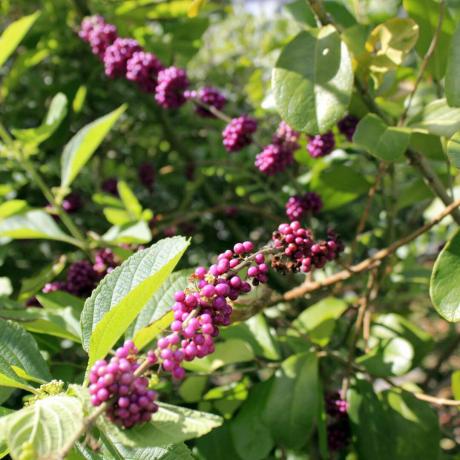
Fuchsias: Popular species, cultivars and wild forms
The variety of fuchsias is immense and grows more and more through breeding. The decision as to which type and variety you want to get for your own garden is therefore anything but easy. We will introduce you to the most important types and varieties on the market:
Popular species of fuchsia
- Fuchsia magellanica: Probably the best known fuchsia species; also known as scarlet fuchsia; forms the basis for many hybrids in breeding; mostly red sepals and purple petals.
- Fuchsia boliviana: Species from the high mountains of the Andes; long, tubular petals; not frost hardy.
- Fuchsia triphylla: Red flowering species from the Caribbean; distinctive racemose inflorescences.

Standing fuchsia varieties
Leverkusen
- Pink flowering variety
- Suitable for the pot
- Growth height up to 50 cm
- Belongs to type Fuchsia triphylla
Shadow dancer
- Available in different colors (pink / red-white / red-pink / white-purple)
- Suitable for the pot
- Bushy growth up to 40 cm
- Partial to shady location
Mary
- Red flower color
- Long flowering period
- 30 to 60 cm high
Maxima
- Showy flower with pink sepals and purple petals
- Heavily branched
- Partially shaded location

Hanging fuchsia varieties
Annabel
- White-pink double flowers
- Suitable for outdoors
- Shady location
Pangea
- Orange-red flower
- Not hardy
- Growth height up to 50 cm
Laurie
- Pink flower color
- Strong-growing
- Partially shaded location

Fuchsia varieties: Hardy fuchsia varieties
Delicate purple
- Pink-purple flower
- Hanging growth habit
- Simple flowers
Dollar princess
- Pink-purple flower
- Suitable as a bush or high trunk
- Double flowers
Cardinal Farges
- Red and white flower
- Partially shaded location
- Simple to double flowers
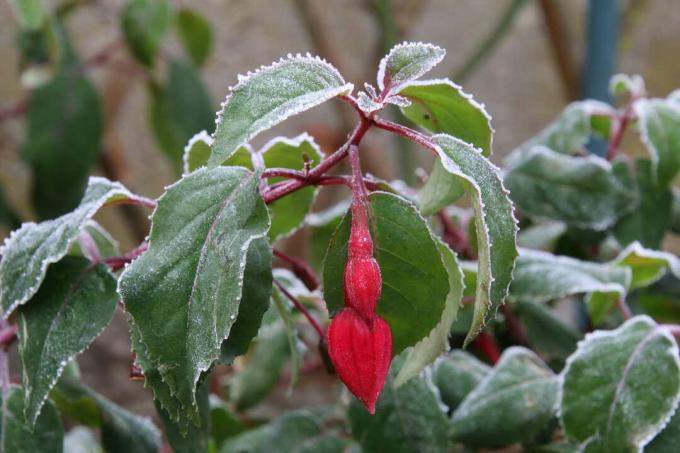
Wild forms of the fuchsia
- Fuchsia procumbens: Particularly unusual variety from New Zealand; very small, variegated flowers; small, dense growth.
- Fuchsia microphylla: Native to Mexico; small, pink flowers; small leaves.
Planting fuchsias in the garden: location and substrate
Due to their exotic origin in South America, fuchsias are among those plants in the garden that place special demands on their environment. We present everything you need to know about the location and the right substrate.
Fuchsias: the right location
Fuchsias originally come from the mountain forests of the Andes and thrive there naturally in a partially shaded environment. So make sure that your fuchsia can find similar conditions in your garden. In particular, excessive solar radiation in the root area can cause problems for the plants.

When do fuchsias go outside?
With the exception of a few varieties, the majority of all fuchsia varieties cannot withstand the frosty winter conditions in this country. After buying it, it is therefore crucial when you put your fuchsia outside or when you plant it. The move outside should definitely happen in April at the earliest, as soon as frost is no longer to be expected. You should not even start planting outdoors until May.
Fuchsias in pots: which substrate is the right one?
When it comes to the substrate for repotting and planting, fuchsias generally do not have high demands, so you can confidently use commercially available potting soil. In any case, this should be permeable and nutrient-rich. For reasons of moor protection, the use of peat-free soil is recommended. Such a peat-free organic soil is also ours Plantura organic potting soilwhich saves up to 60% CO2 compared to conventional soils.
When choosing the location, pay attention to the following criteria:
- Partially shaded location
- Shadows in the root area
- In the pot outside from April; outdoors from May
- Peat-free potting soil as a substrate
Propagating fuchsias yourself: how does it work?
Propagate fuchsias, is not a complicated undertaking and every hobby gardener succeeds with just a few tricks. The fastest and most effective method for this is to grow fuchsia cuttings. To do this, proceed as follows:
- In summer, cut off an approximately 10 cm long shoot from the plant.
- At the lower end of the shoot, remove the leaves and plant at least half of the cutting.
- Use nutrient-poor and well-drained growing media such as the Plantura organic herb & seed compost.
- Always keep the cutting warm and moist. Direct sunlight should be avoided if possible.
After a short time, the cutting will develop new roots. It's always worth pulling multiple cuttings in parallel to maximize your chances of success.
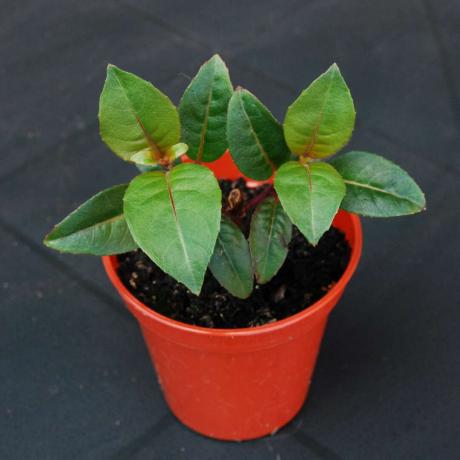
Maintaining fuchsias: important tips and tricks
As an ornamental plant, fuchsias are essentially alien in Central Europe - it is therefore not surprising that the care and conditions in their environment are a little different than those at home Plants. We provide everything you need to know Care of fuchsias before.
Watering fuchsias properly
As a classic plant from the mountain forests of the tropics, two factors are always at the top of the list for fuchsias: lots of water and high humidity. Regular watering is very important for plant health, so the roots should never dry out completely. Water your fuchsia daily, and spray the leaves from time to time if possible.
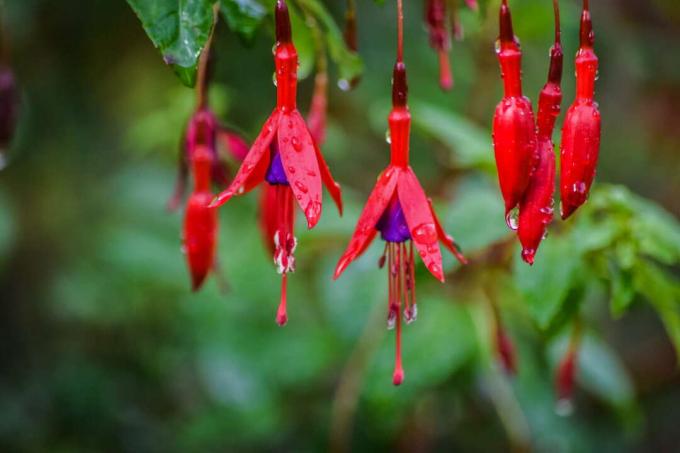
Fertilize fuchsias properly
The supply of nutrients is particularly important for fuchsias so that they can grow well throughout the summer and develop profuse blooms. The following applies to fertilization: In the first few months after repotting, additional fertilizer should be avoided. Over-fertilization should also be avoided afterwards, as fuchsias are sensitive to excessive amounts and the roots burn quickly. Liquid fertilizers provide nutrients quickly, but improper use often leads to overdosing. Therefore you should use an organic liquid fertilizer like our Plantura Organic flower & balcony fertilizer also always dose according to the information on the packaging, so you rule out over-fertilization.
Cut fuchsias
The skill Cutting a fuchsia should be carried out every year in order to preserve the lush flowers of the tropical plant. Fuchsias always bloom on the young shoots, so cut back the dead shoots every autumn. You don't need to be very careful, it is just important that the heavily lignified parts of the plant are not cut back too much.
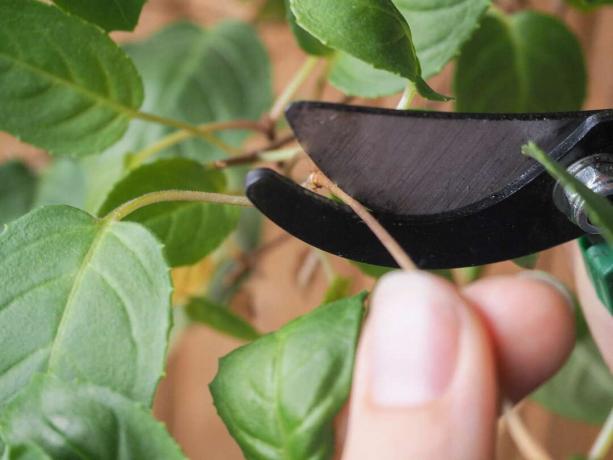
When caring for fuchsias properly, consider these aspects:
- Water regularly
- Spray the plant with water every now and then
- Fertilize regularly but little; ideally with organic means such as compost
- Prune annually in autumn
Skillfully hibernate fuchsias
An unfortunate trait for many hobby gardeners is the great sensitivity of the beloved fuchsia to frost. Except for a few hardy fuchsia varieties Most specimens are therefore cultivated in pots and placed in a frost-free place in winter. In any case, cut back the bush in the fall and provide a place that meets the following criteria:
- Cool (frost-free, at least 2 ° C)
- Dark
- Dry
In spring, overwintered fuchsias can be slowly adapted to the light and warmth outside. Hardy specimens in the garden should always be properly covered with straw and leaves as well as a garden fleece for the winter. Here, however, the following applies: Unfortunately, there is no guarantee that the plant will return in a cold winter. How to use hardy fuchsias best deals, we show here.


